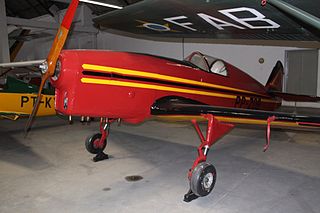Related Research Articles

The Harbin Y-11 is a high wing twin-engine piston utility and geological survey aircraft built by Harbin Aircraft Manufacturing Corporation (HAMC).

The CNNA HL-1 was a light utility aircraft developed in Brazil in 1940. It was a high-wing strut-braced monoplane with fixed tailskid undercarriage and seating for two persons in tandem.

The CNNA HL-6 was a civil trainer aircraft developed in Brazil in 1943.

The RWD-16 was a Polish two-seat low-wing sports plane of 1936, constructed by the RWD team, that remained a prototype.
The Casmuniz 52 was a twin-engine light transport aircraft. It was the first all-metal aircraft built in Brazil, only the prototype was built.
The Yakovlev Yak-20 was an experimental piston-engined trainer developed in the Soviet Union in 1949. It did not go into production.

The Ambrosini Rondone is an Italian-designed two/three-seat light touring monoplane of the early 1950s.
The IABSA Premier 64-01 was a Brazilian two-seat training and touring braced high-wing monoplane designed and built in small numbers by Industria Aeronáutica Brasileira (IABSA), powered by a 75 hp (56 kW) piston engine.

The Hispano Suiza E-30, later renamed Hispano E-30, was designed in Spain in 1930 as a multi-purpose intermediate trainer. It was a single engine, parasol wing monoplane. About 25 served with the Spanish armed forces until 1945.

The Hispano-Suiza E-34, later renamed Hispano HS-34, was a Spanish single engine, tandem seat biplane, designed as a basic trainer. Twenty five were ordered by the Aeronáutica Naval, but only five had been completed when the Spanish Civil War intervened.

The IPT-16 Surubim was a Brazilian single-seat, single engined experimental light aircraft. A single example was built and flown in 1959.
The IAR-817 was a Romanian multipurpose aircraft built in the 1950s.

The IAR-811 was a Romanian trainer aircraft built in the late 1940s. It was the first aircraft designed and built in Romania following the end of the Second World War.

The Embraer EMB 400 Urupema initially called IPD 6505 Urupema, is a Brazilian glider developed at Instituto Tecnológico de Aeronáutica, São José dos Campos, in 1964, and later produced by Embraer.
The Niess 1-80, also known as Galeão 5 FG, was a military and civilian trainer aircraft built in Brazil during the 1950s. It was originally developed by Marc Niess as an prototype based on the CAP-4 Paulistinha, which he worked while employed at Companhia Aeronáutica Paulista.
The Niess 2-100, was a civilian two-seat high-wing sport aircraft built in Brazil during 1952.
The Alvear was a Brazilian single-engine, single-seat aircraft.
The SP-18 Onça also known as the IPAI-27 Jipe Voador, was a Brazilian single-seat, single engined experimental agricultural aircraft.
The IPAI-26 Tuca was a Brazilian single engined high-wing light utility aircraft.

The IPT-7 Junior was a light aircraft manufactured by the Brazilian Instituto de Pesquisas Tecnologicas (IPT).
References
- ↑ Bridgman, Leonard (1947). Jane's All the World's Aircraft 1947. Vol. 1. New York, NY: Macmillan Publishers. p. 9c. ASIN B000RMJ7FU.
- 1 2 3 4 Pereira, Roberto (1986). História da Construção Aeronáutica no Brasil 1910-1976. Vol. 1. São Paulo: Editora Aquarius. pp. 45–49. ISBN 9788585262693.
- 1 2 3 4 5 Pereira, Roberto (2013). Construção Aeronáutica no Brasil - 100 Anos de História. Vol. 1. São José dos Campos: JAC Editora. pp. 213–216. ISBN 978-85-85262-69-3.